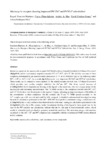Mostrar o rexistro simple do ítem
Macrocyclic receptor showing improved PbII/ZnII and PbII/CaII selectivities
| dc.contributor.author | Ferreirós-Martínez, Raquel | |
| dc.contributor.author | Platas-Iglesias, Carlos | |
| dc.contributor.author | Blas, Andrés de | |
| dc.contributor.author | Esteban-Gómez, David | |
| dc.contributor.author | Rodríguez-Blas, Teresa | |
| dc.date.accessioned | 2020-04-02T11:41:02Z | |
| dc.date.available | 2020-04-02T11:41:02Z | |
| dc.date.issued | 2010-05-31 | |
| dc.identifier.citation | Ferreirós‐Martínez, R., Platas‐Iglesias, C., de Blas, A., Esteban‐Gómez, D. and Rodríguez‐Blas, T. (2010), Macrocyclic Receptor Showing Improved PbII/ZnII and PbII/CaII Selectivities. Eur. J. Inorg. Chem., 2010: 2495-2503. | es_ES |
| dc.identifier.issn | 1099-0682 | |
| dc.identifier.uri | http://hdl.handle.net/2183/25291 | |
| dc.description.abstract | [Abstract] Herein we report on the macrocyclic receptor N,N′‐bis[(6‐carboxy‐2‐pyridyl)methyl]‐1,10‐diaza‐15‐crown‐5 (H2bp15c5) and its coordination properties towards ZnII, CdII, PbII, and CaII. The stability constants of these complexes determined by pH‐potentiometric titration at 25 °C in 0.1 M KNO3 vary in the following order: PbII > CdII >> ZnII > CaII. As a result, bp15c5 presents very important PbII/ZnII and PbII/CaII selectivities. These results are in contrast to those reported for the related receptor derived from 1,7‐diaza‐12‐crown‐4, which provides very similar complex stabilities for ZnII and PbII. The X‐ray crystal structure of [Cd(Hbp15c5)]+ shows heptadentate binding of the ligand to the metal ion, with two oxygen atoms of the macrocyclic unit remaining uncoordinated. The 1H NMR spectra of the complexes formed with PbII, ZnII, and CaII (D2O) show very broad peaks in the region 2–5 ppm, indicating an important degree of flexibility of the crownmoiety in these complexes. On the contrary, the 1H and 13C NMR spectra recorded for the CdII complex are well resolved and could be fully assigned. A detailed conformational investigation using theoretical calculations performed at the DFT (B3LYP) level predict a minimum energy conformation for [Cd(bp15c5)] that is very similar to that observed in the solid state. Analogous calculations performed on the [M(bp15c5)] (M = Zn or Pb) systems predict hexadentate binding of the ligand to these metal ions. In the case of the PbII complex our calculations indicate that the 6s lone pair is stereochemically active, which results in a hemidirected coordination geometry around the metal ion. The minimum energy conformations calculated for the ZnII, CdII, and PbII complexes are compatible with the experimental NMR spectra obtained in D2O solution. | es_ES |
| dc.description.sponsorship | Xunta de Galicia; PGIDIT06TAM10301PR | es_ES |
| dc.description.sponsorship | Xunta de Galicia; INCITE09E1R103013ES | es_ES |
| dc.language.iso | eng | es_ES |
| dc.publisher | Wiley | es_ES |
| dc.relation.uri | https://doi.org/10.1002/ejic.200901219 | es_ES |
| dc.rights | This is the peer reviewed version of the following article: Ferreirós‐Martínez, R., Platas‐Iglesias, C., de Blas, A., Esteban‐Gómez, D. and Rodríguez‐Blas, T. (2010), Macrocyclic Receptor Showing Improved PbII/ZnII and PbII/CaII Selectivities. Eur. J. Inorg. Chem., 2010: 2495-2503 which has been published in final form at https://doi.org/10.1002/ejic.200901219. This article may be used for non-commercial purposes in accordance with Wiley Terms and Conditions for Use of Self-Archived Versions. | es_ES |
| dc.subject | Macrocycles | es_ES |
| dc.subject | Selectivity | es_ES |
| dc.subject | Lead | es_ES |
| dc.subject | Cadmium | es_ES |
| dc.subject | Crown compounds | es_ES |
| dc.title | Macrocyclic receptor showing improved PbII/ZnII and PbII/CaII selectivities | es_ES |
| dc.type | info:eu-repo/semantics/article | es_ES |
| dc.rights.access | info:eu-repo/semantics/openAccess | es_ES |
| UDC.journalTitle | European Journal of Inorganic Chemistry | es_ES |
| UDC.volume | 2010 | es_ES |
| UDC.issue | 17 | es_ES |
| UDC.startPage | 2495 | es_ES |
| UDC.endPage | 2503 | es_ES |
Ficheiros no ítem
Este ítem aparece na(s) seguinte(s) colección(s)
-
GI-REACT! - Artigos [103]






